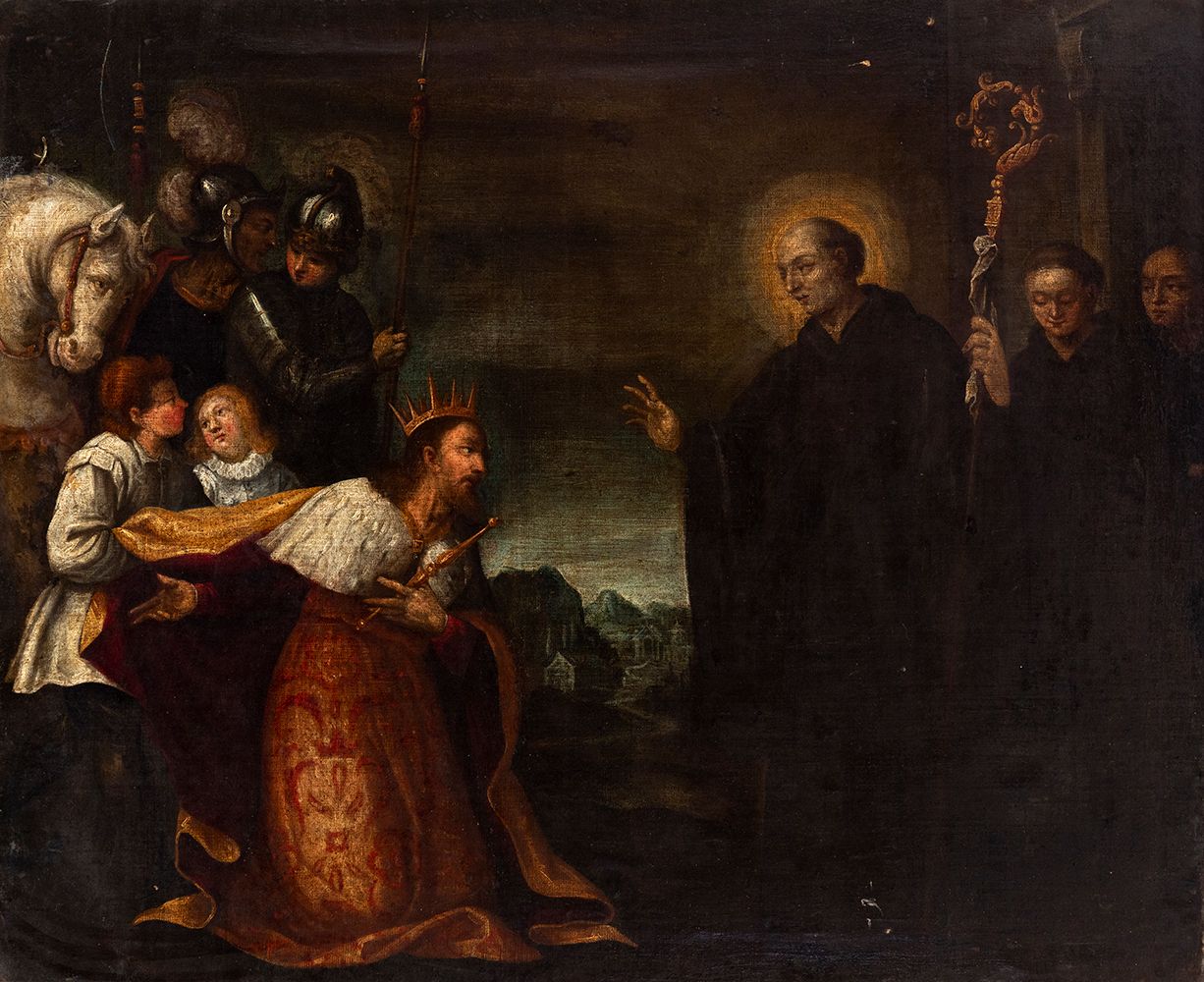Description
Italian school; 17th century. “San Benito y Totila”. Oil on canvas. Re-coloured. It has repainting and a slight hole in the canvas. Needs cleaning. It has an Andalusian frame, from the XVII century, with faults in the carving. Measurements: 77,5 x 95 cm; 87 x 104 cm (frame). This work contains the religious story in which the encounter between Saint Benedict and King Tolila is narrated. The fame of Saint Benedict spread to such an extent that the king of the Goths, Tolila, decided to meet the saint and to see for himself the qualities attributed to the saint. For this reason, Totila arranged a visit with the saint. However, he ordered a representative of his court, Riga, to appear before St. Benedict as if he were Benedict himself, to see if the saint truly possessed the gift of prophecy, and divined the deception. When Rigo entered the monastery, Saint Benedict, who was sitting at the door, said to him "Take that off, son, take off that thing you are wearing, it is not yours". After Totila was discovered, he presented himself in the monastery, but embarrassed by his ruse, he did not dare to approach St. Benedict and prostrated himself on the ground. It was then that Saint Benedict approached him, lifted him off the ground, and said to him "You do much harm, it is time for you to put an end to your wickedness", in reference to the bellicose reputation of the Gothic king. In this particular scene, the author shows the moment in which King Totila is prostrate before the saint, after having tried to deceive him. Saint Benedict, on the right of the composition, holds his crosier, while with the other hand he holds out his open palm to the king in an attitude of vehemence. Both figures are accompanied by a retinue, the king's being particularly colourful and the presence of the horse, which shows the artist's interest in demonstrating his technical mastery. Arranged in the form of a frieze, all the figures are in the foreground, leaving a slight space in the centre, which gives depth to the scene by allowing the viewer to observe a landscape conceived through successive planes.
48
Italian school; 17th century. “San Benito y Totila”. Oil on canvas. Re-coloured. It has repainting and a slight hole in the canvas. Needs cleaning. It has an Andalusian frame, from the XVII century, with faults in the carving. Measurements: 77,5 x 95 cm; 87 x 104 cm (frame). This work contains the religious story in which the encounter between Saint Benedict and King Tolila is narrated. The fame of Saint Benedict spread to such an extent that the king of the Goths, Tolila, decided to meet the saint and to see for himself the qualities attributed to the saint. For this reason, Totila arranged a visit with the saint. However, he ordered a representative of his court, Riga, to appear before St. Benedict as if he were Benedict himself, to see if the saint truly possessed the gift of prophecy, and divined the deception. When Rigo entered the monastery, Saint Benedict, who was sitting at the door, said to him "Take that off, son, take off that thing you are wearing, it is not yours". After Totila was discovered, he presented himself in the monastery, but embarrassed by his ruse, he did not dare to approach St. Benedict and prostrated himself on the ground. It was then that Saint Benedict approached him, lifted him off the ground, and said to him "You do much harm, it is time for you to put an end to your wickedness", in reference to the bellicose reputation of the Gothic king. In this particular scene, the author shows the moment in which King Totila is prostrate before the saint, after having tried to deceive him. Saint Benedict, on the right of the composition, holds his crosier, while with the other hand he holds out his open palm to the king in an attitude of vehemence. Both figures are accompanied by a retinue, the king's being particularly colourful and the presence of the horse, which shows the artist's interest in demonstrating his technical mastery. Arranged in the form of a frieze, all the figures are in the foreground, leaving a slight space in the centre, which gives depth to the scene by allowing the viewer to observe a landscape conceived through successive planes.
